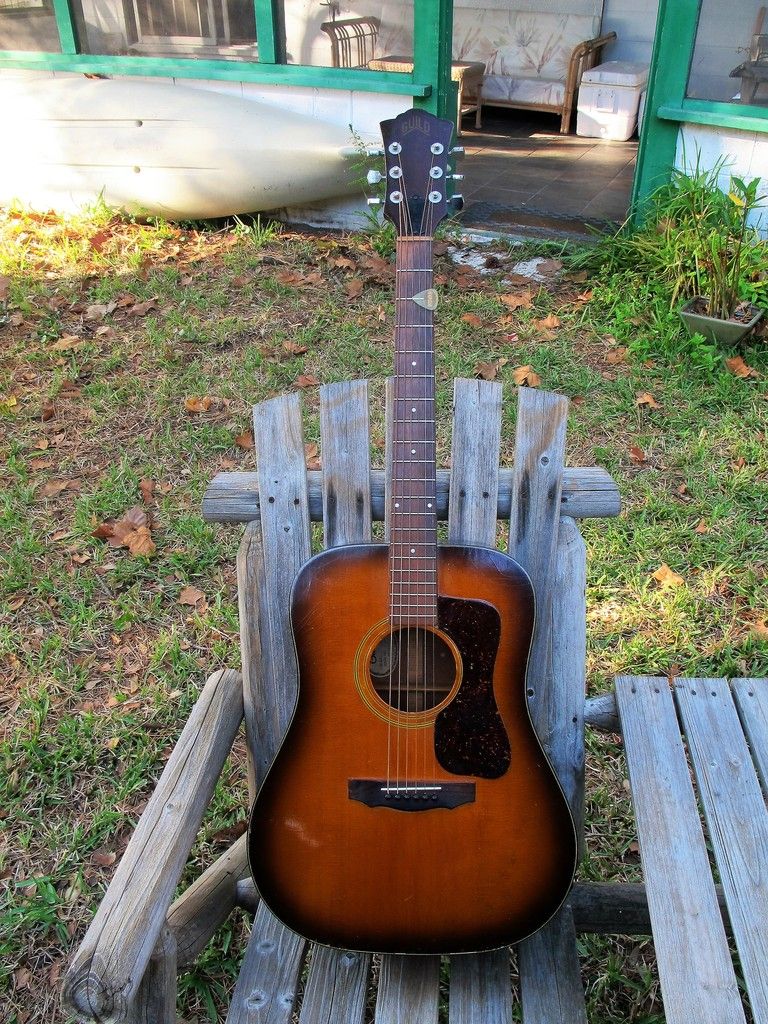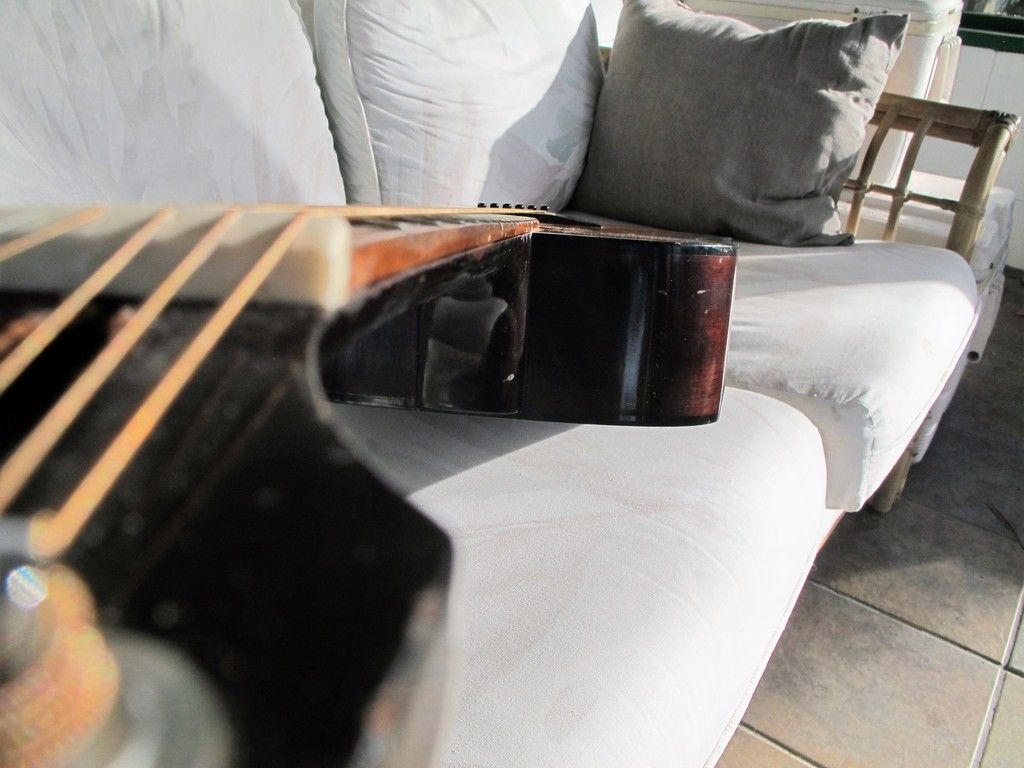
 |
|
#1
|
|||
|
|||
|
The neck is bowed and while trying to adjust truss rod to straighten, the nut on truss rod broke off. I brought it to a local Luthier and he said there was enough thread left on the truss rod to re-attach the adjustment nut. He did this but the neck would still not flatten out. He then said the truss rod must be broken under the fret board and that he could replace the truss rod for $250. I agreed to let him do the job. When I got the guitar back I still could not get the neck to flatten out. If I take the tension off truss rod it will bow uniformly, see picture 3. When I tighten down on the truss rod the neck only gets flat to the 7th fret but still has a dip from there to the body of the guitar, see picture 7&9. The local luthier now says I need a neck reset. Can anyone help me understand what is going on here? Thanks, Rob.
D35SB  [IMG] [IMG]Truss rod loose [IMG]  [/IMG] [/IMG]Truss rod tight [IMG]  [/IMG] [/IMG][IMG]  [/IMG] [/IMG]Last edited by Flyyaker; 02-02-2017 at 06:01 PM. |
|
#2
|
|||
|
|||
|
|
|
#3
|
|||
|
|||
|
I am still trying to figure out posting pictures, sorry. Those are two example pictures but I am referring to pictures 3 & 7,9 which show fretboard with loosen rod and rod tight.
|
|
#4
|
|||
|
|||
|
Pictures 4 and 8 show the truss rod nut itself and the amount I tightened it.
|
|
#5
|
|||
|
|||
|
There appears to be a bunch of stuff going on with your guitar, though I'd need it in front of me to clearly differentiate what is what.
The fingerboard is not level, it looks like the bridge is detaching. It looks like the truss rod is tightened to the point of back-bowing the first frets. Truss rods do not effect the neck in the higher frets, so no amount of adjustment will flatten that area. From the photos, it likely does need a neck reset, or a shaving of the very thick bridge, if one believes in that approach to correction. I'd want to inspect the neck block area, including whatever braces are there, to ensure the top is not collapsing in that area, contributing to the "ski ramp" shape of the upper fingerboard. I'd have hoped that the person doing the truss rod repair would have inspected all of that prior to replacing the rod and identified what needed to be done to bring the instrument back to good playing condition. |
|
#6
|
|||
|
|||
|
I was thinking the same thing about the luthier. But I am still confused as to why I can't flatten the fret board. I have seen a guitar that needs a neck reset but that doesn't have anything to do with the neck having a 7th fret dip does it? I have read you can loosen truss rod and clamp it flat then re-tighten truss rod but I have not trying.
Charles I re-read your post and you have answered my question about the bowed area of my neck, thanks. Last edited by Flyyaker; 01-18-2017 at 11:03 AM. |
|
#7
|
|||
|
|||
|
Quote:
I will give a point of view regarding some of the issues you have had First you need to understand a truss rod does not make a neck straight, the truss rod is there to strengthen the neck from its shaping process and also allows some functionality to be able to further combat string tension. It in no way removes a warp or twist and so forth. When you have snapped the truss rod nut off, the luthier as per your comments repaired the threaded section. When you could not adjust the truss rod enough to make it straight, the luthier replaced the truss rod for you. Have you relayed to your luthier what the main issue actually is and what it is you actually are trying to achieve, it simply sounds to me like you have been getting the luthier to only repair the issues after the fact. I am not defending the luthier, I have no idea of the work scope they were contracted too, but clarification goes a long way in this industry From your pictures only. I suspect, the frets need to be removed, fretboard levelled and refretted, also you may have some inherent twist happening in the neck as well, so that needs possible addressing at the same time. Steve
__________________
Cole Clark Fat Lady Gretsch Electromatic Martin CEO7 Maton Messiah Taylor 814CE Last edited by mirwa; 01-18-2017 at 07:02 PM. |
|
#8
|
|||
|
|||
|
I told the luthier that I broke the nut off my truss rod while adjusting it. Everything he did was done on the his recommendations. I have brought the guitar back to him after he put the new truss rod in to have him adjust the neck relief and the first time he put clamps on the fret board and tighten the truss rod to get it flat. That adjustment did not hold for more than a week. The second time he told me that the truss rod was doing all it could do and that I need a neck reset. There is still a noticeable dip starting at the 7th fret and continuing to the body of the guitar. I am playing the guitar as is with higher action than I would like up the neck. I am not necessarily questioning the luthier's work but rather trying to better understand why I can't get the fret board straight and flat. I know these guitars were not made well, lot's of inconsistencies and it is 55 years old but I just want to better understand what I am seeing.
|
|
#9
|
|||
|
|||
|
If a neck has no truss rod, or the truss rod is completely loose, the string tension will pull the neck into a concave-up curve, pulling the nut end of the neck upwards. Provided that the neck juncture - neck joint, interior bracing and neck block - are "rigid", the neck curves from about the 10th fret. (It is essentially a cantilevered beam.)
 That is, with a "rigid" neck/body, the fingerboard beyond/higher than about the 10th fret is not effected by the string tension. When an adjustable truss rod is tightened, it, similarly, does not effect the curvature of the neck/fingerboard in the upper frets. It only alters the curvature of the cantilevered portion of the neck. If the surface of the fingerboard is not "true" - it contains humps and valleys, adjusting of the truss rod will not alter that. As some/many instruments age, the constant string tension deforms the body of the guitar, typically with the upper bout rotating "into" the soundhole. Since the neck is rigidly attached to the body, the angle the neck makes relative to the original plane of the top changes: the plane of the top where the bridge is attached, more or less, remains constant while the upper bout rotates. The result is that the string height increases relative to the surface of the fingerboard: the fingerboard moves away from the strings. The usual remedy is to remove the neck, alter the angle it makes with the body to restore the angle of the neck relative to the plane of the top at the bridge. This is a neck reset. Adjusting the truss rod will not alter the angle that the neck makes with the body. In your guitar, based on the photos, it appears that 1. the surface of the fingerboard is not true, with several possible causes 2. the truss rod has been adjusted to the point that the neck is back-bowed in the lower frets, which will not correct 1, above 3. it might be that the neck angle is incorrect - either a neck reset or bridge shave might be in order 4. it appears that the bridge is lifting, raising the string height at the bridge |
|
#10
|
|||
|
|||
|
Thank you Charles, this is a very clear explanation and after reading it I see what you are explaining when I look at my guitar. The guitar is playable so I think I will back off on the truss nut a little and get the neck as flat as I can.
|
|
#11
|
|||
|
|||
|
Quote:
As others have mentioned, the rod does not affect the upper portion of the neck, and no amount of messing with the truss rod will change that. The luthier that replaced the rod couldn't have known what the guitar would look like under string tension with the rod properly adjusted until he actually finished the job - but he could have anticipated the likelihood of other problems (neck angle problems, frets) and warned you accordingly. In my shop, any time a customer is paying me to do a job, I always consider what issues are likely to arise as the job progresses, and I do my best to warn the customer of the potential problems before they come up. It comes as much less of a shock to the customer if they were warned of the possibility of such issues arising, and furthermore, it may affect their decision of whether or not to have the work done in the first place. Now the OP has spent $250, and the guitar still is not in good playing condition. Since your luthier (probably) did not mention this, I will: After the neck reset, the guitar will almost certainly need a refret if you want it to play well. The fingerboard is wonky as hell, and a neck reset will not change that. Therefore, after the neck angle is corrected, the frets must be pulled and the fingerboard must be leveled so that the upper portion is straight under string tension. And yes - the bridge is pulling up. That needs to be dealt with too. IMO your luthier should have anticipated these issues, or at least suspected the possibility of these issues arising before advising you to pay him $250 for replacing the rod. Hopefully he will learn from this experience.
__________________
https://www.reverbnation.com/bootheelers Last edited by Hot Vibrato; 01-19-2017 at 09:43 AM. |
|
#12
|
|||
|
|||
|
I have learned a lot from this experience, a valuable lesson. I'm not sure if the luthier I used learned anything.
When I wrote that I would back off on the truss rod I ment loosening it to relieve the back bowing. Thanks for your input and advice. |